Abstract
This study examines the spatial root development patterns of bareroot, containerized, and plug plus (plug+) saplings in hemiboreal forests of Latvia, focusing on the effects of two common soil preparation methods: mounding and disc trenching. In northern Europe, forest regeneration after clearcutting often involves planting, with soil preparation aimed at enhancing sapling survival and productivity. This study included four tree species: Pinus sylvestris, Picea abies, Betula pendula, and Alnus glutinosa. The results reveal that saplings planted in mounded sites developed more radially symmetrical root systems, while roots in trenched sites predominantly grew parallel to the furrow. This spatial root distribution was consistent across all forest types and did not show significant variation between stock types (containerized, bareroot, or plug+) or treatments (control or fertilized). Additionally, the number of main roots did not differ significantly between the soil preparation methods. These findings align with previous research and raise important questions regarding the impact of early root architecture on stand resilience at a mature stage, particularly in relation to windthrow, heavy snowfall, drought, and flooding resistance. The study underscores the need to consider root system development as a key factor in forest management practices aimed at ensuring long-term forest stability.
1. Introduction
Soil preparation is crucial for promoting the productivity and survival of young saplings [1,2,3]. The outcomes and economic investments associated with soil preparation vary depending on the interaction between environmental factors and the chosen soil preparation method. These methods influence sapling development by altering factors such as soil temperature [4], soil structure, water retention [5], nutrient distribution, light availability, and vegetation competition [6,7].
In Latvia, disc trenching has been the predominant method for site preparation, while mounding has historically been used to a lesser extent [5]. However, interest in mounding has increased in recent decades [8]. Thus, in commercial forests, this practice is relatively new, and insufficient time has passed to objectively evaluate the benefits and drawbacks of disc trenching compared to mounding at a mature forest stage. Consequently, young stands must be studied to identify patterns, compare them to mature stands, and monitor their development over time.
There is an assumption that the microrelief created during soil preparation levels out relatively fast [5], providing benefits and support primarily during the early development of the stand, when it is the most needed [9]. During these early years, the root pattern and coarse root distribution develop, and the general distribution of roots often becomes less flexible over time. Thus, it remains unclear to what extent trees can adapt to disturbances with mainly fine roots and compensatory root growth after the main root layout has already developed, especially if the disturbances are sudden. Research has found that root architecture, in combination with the soil type, water table, and stem weight, affect uprooting susceptibility [10,11], thus raising the question of the role of the soil preparation method in determining the architecture of roots and the stands’ long-term resilience. The quality of the soil preparation process is also a factor to consider; in some cases, deep furrows from disc-trenched sites remain visible even after 60 years (personal observation).
Additionally, it has been suggested that the planting material type (stock) also influences root development [12]. In commercial hemiboreal forests, three main stock types are typically used: containerized, bareroot, and plug+ (container seedlings transplanted into bareroot beds and allowed to grow for one additional year in the nursery prior to outplanting) [13]. Previous research, which assessed containerized seedlings, revealed that the roots of Scots pine (Pinus sylvestris L.) and Norway spruce (Picea abies (L.) H. Karst.) during the first years after outplanting in trenched sites tend to grow parallel to the furrow (when planted on the hinge) and rarely penetrated into the berm, whereas in mounded sites, roots developed more radially symmetrically [14]. These are two of the most economically important species in northern Europe. However, during a study comparing soil preparation methods for sapling development, we noticed a similar pattern in silver birch (Betula pendula Roth) and black alder (Alnus glutinosa (L.) Gaertn.). Birch and alder mainly have a lateral root system, without distinct taproot formation [15,16]. These species are better adapted to withstand periodical waterlogging but may suffer during prolonged drought periods [17]. Mounds have a higher risk of drying out; thus, for such species, disc trenching as a soil preparation method may be more suitable, especially in areas where drought is common [4,18].
While at an early stage of development, root architecture is unlikely to significantly affect the survival of the saplings; it may become more important at a mature age. In mature stands, coniferous species are considered to be more prone to wind damage than broadleaves; however, it depends on multiple site conditions, as well as the specific species [11]. There are multiple factors that can be at play, including the evergreen nature of conifers, weaker timber, excurrent crown shape, poorer site conditions compared to broadleaved sites, overall lower root density within the stand, as well as a shallow or asymmetrical root plate [11,19,20,21]. Thus, different species may have different site preparation method requirements, both based on root characteristics and stress tolerance differences.
In this article, we report results originating from two studies that were not specifically designed to address root architecture, but during which we noticed reoccurring root spatial distribution patterns. One was initially designed for the stock type, forest type, soil preparation method and species interaction assessment, and the other was designed to evaluate the effectiveness of a fertilizer.
The aim of this article is to evaluate the effect of the soil preparation method, stock type, forest type, and fertilization on early root spatial development of Scots pine, Norway spruce, silver birch, and black alder in field conditions. We hypothesize that early root development pattern differences between forest types and species will be minimal, but the stock type will influence the root spatial distribution due to differences in the planting process. Specifically, containerized seedlings are expected to have more radially symmetrical roots compared to bareroot and plug+ seedlings. Additionally, we anticipate that mounds will promote radial symmetry, while trenches will result in a bidirectional root system.
Beyond these hypotheses, this work carries practical implications for forest managers seeking to improve long-term stand resilience and productivity. Understanding how early root development interacts with planting materials, site preparation, and environmental conditions can inform decisions on stock selection and site treatment, ultimately shaping forest performance under changing climatic conditions. Future research should extend these investigations to long-term monitoring, explore additional soil preparation techniques, and model how these early patterns impact mature stand dynamics, especially in the face of disturbances such as storms or drought.
2. Materials and Methods
The research data originate from two separate larger-scale studies: A and B (Figure 1). While the goal of these studies was not directly connected to root spatial distribution, during the data collection, differences in root spatial development were noticed; thus, in this article, the authors assess and focus only on the aspect of root spatial development. Inclusion of two separate studies increases the data set on which the conclusions are based. However, it also causes some limitations, since the study designs of A and B differ and were not originally developed to specifically address root architecture. Both studies were conducted in commercial forests that were established following guidelines of JSC “Latvia’s State Forests”. Non-destructive methods were selected in study site A, and only specific additionally planted trees (extras) were excavated in study site B, to avoid disrupting commercial forest compliance with regeneration requirements.
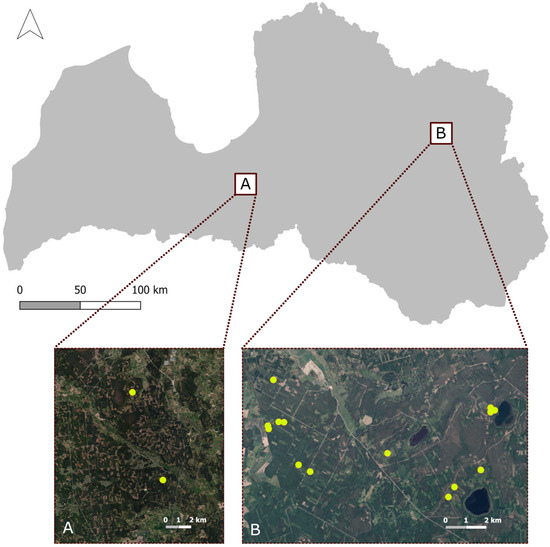
Figure 1.
Location of study sites (A) and (B) (yellow dots represent locations of forest stands where sampling was performed).
2.1. Study A
The study site for A was established in two forest types: Myrtilloso–sphagnosa and Myrtillosa turf. mel. (according to Latvian forest type classification [22]). Myrtillosa turf. mel. is a forest type on semi-rich organic soil (peat layer < 20 cm) that has been drained and is considered meso-eutrophic. Myrtilloso–sphagnosa are non-drained forests on mineral soil (podzolic and gleyic loam or sandy loam soils, often with an ortstein layer) and are considered mesotrophic.
The soil preparation method was either mounding or disc trenching, as these are the currently most widely used methods in boreal forests and in Latvia. Site A was prepared in the autumn of 2017, and seedlings of Norway spruce (Picea abies), Scots pine (Pinus sylvestris), silver birch (Betula pendula), and black alder (Alnus glutinosa) were planted in the spring of 2018. The planting material was either containerized, bareroot, or plug+. Bareroot and plug+ were planted using a spade, but containerized seedlings were planted using a tube planter.
To evaluate root development in 2022, five (or six) trees of each species, the soil preparation method and stock type combination were selected and their root plate uncovered (soil removed in up to 1 m radius around the root collar) to assess the root distribution and the number of main coarse roots with diameter ≥ 2 mm [23]. Trees were five (containerized and bareroot) to six (plug+) years old at the time of the survey, resulting in a total of 182 trees assessed, 91 in mounded areas and 91 in trenched (Table 1). The root distribution was noted at observation frequency in eight segments of a circle, with a furrow or mounding pit serving as reference points (Figure 2). The direction of roots in relation to cardinal points was also noted. After inspection, the roots were once again covered with soil. Due to the application of a non-destructive method, the root mass, as well as root area, length, and depth, were not assessed; thus, we cannot address the soil preparation methods’ effect on the overall belowground development in different dimensions.

Table 1.
Number and type of sample trees in study site A.
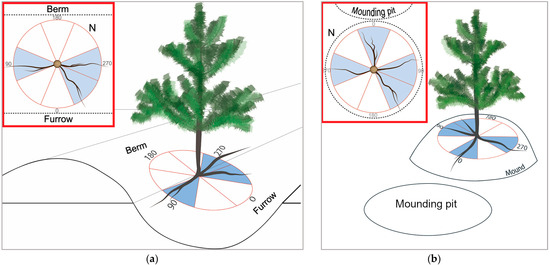
Figure 2.
Schematic representation of root direction survey method in trenched (a) and mounded (b) sites, where coarse root observations in each segment are noted (in light blue) in relation to furrow or mounding pit (represented as “0”) and cardinal points (“N” represents north). Schematic top view is shown in red frames.
2.2. Study B
Study site B was established in 13 locations of six forest types: Mercurialiosa mel. (eutrophic forest type with drained, rich carbonatic mineral soils), Myrtillosa turf.mel. (meso-eutrophic forest type with drained, rich organic soils), Hylocomiosa (mesotrophic forest type with relatively dry semi-rich sandy loam, loam, or clay soils), Vacciniosa (oligo-mesotrophic forest type with relatively dry, poor, sandy soils), Vaccinioso–sphagnosa (oligo-mesotrophic forest type with relatively wet, poor, sandy soils), and Aegopodiosa (eutrophic forest type with relatively dry, rich, carbonatic mineral soils).
In the spring of 2020, one-year-old containerized pine seedlings were planted in eight locations and two-year-old containerized spruce seedlings in five locations. Initially, the main objective of this study was to evaluate the effect of arGrowTM (Arevo AB, Umeå, Sweden) biostimulant containing L-arginine phosphate (C6H17N4O6P) on seedling development. Half of the seedlings were planted with the addition of arGrowTM (fertilized) in one dose (~0.4 g), which was added using a dosing feeder into the planting hole at the moment of planting, while the other half was planted as control (Table 2). Due to the main focus of this study design originally being on the fertilization effect, the study does not equally cover all possible forest type, species, and soil preparation method combinations.

Table 2.
Number and type of extra trees in study site B.
In mounded areas, circular sample plots of 25 m2 were established, and in trenched areas, sampling plots were established in 10 m long by 2.5 m wide strips, so that both furrows created by a single movement of a disc trencher would be included. In study site B, only specifically planted additional trees (“extras”) were dug out, but not all locations had five viable trees for root assessment; thus, 138 trees were dug out in the fall of 2021, and 128 trees were excavated in the fall of 2022. Trees were three (pine) to four (spruce) years old in 2021 and four to five years old in 2022. The direction of the roots in relation to the trench or mound pit was noted during the digging up of the trees. Additionally, to evaluate the effect of fertilization at planting, the root length of the three longest roots and the maximum depth of the roots were also measured. Extra trees were collected; their roots were separated from the aboveground part and scanned with an EPSON Expression 12000XL (Seiko Epson Corporation, Suwa, Nagano Prefecture, Japan) from both sides to calculate the root projected area (refers to the two-dimensional area that the roots of a plant cover when projected onto a flat surface, which can relate to how efficiently the plant can take up water and nutrients) in mm2 using the WinRHIZO program. The roots were then dried and weighed. Within the scope of this article, the effect of fertilization on aboveground parts is not discussed.
2.3. Data Analysis
The coarse root distribution was registered as the observation frequency within eight classes that represent eight segments of a circular plot in relation to the furrow or mounding pit. The coarse root count was noted. Data were non-parametric; thus, statistical differences in the root frequency distribution were assessed with the chi-square test using R software version 4.4.2 [24].
In study B, the effect of the forest type, soil preparation method, and fertilizer on the root length, weight, and projected area were analyzed using generalized linear models (glm) with a 95% confidence interval. The best model was selected based on the lowest AIC value.
3. Results
3.1. Effect of Soil Preparation Method and Stock Type on Early Root Architecture of Different Species
When comparing each species, there was no statistically significant difference in root distribution between trees in the forest types Myrtilloso–sphagnosa and Myrtillosa turf. mel. in study A. The differences between stock types (within species) in study A—containerized, bareroot, and plug+—were not statistically significant (p = 0.55). Visually, there appears to be a tendency that, in trenched areas, black alder (and to a lesser extent birch) containerized seedlings develop more radially distributed roots compared to other species and stock types (Figure 3, Figure 4, Figure 5 and Figure 6). In mounded areas, all species and stock types developed roots radially distributed and did not lean toward any particular cardinal point or microrelief, such as the mounding pit.

Figure 3.
Coarse root distribution of silver birch depending on soil preparation method and stock type (mounding pit or furrow are represented by 0 degrees, and berm is represented by 180 degrees).
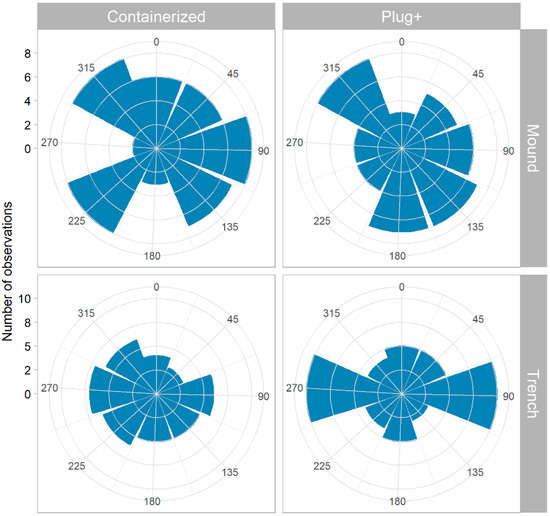
Figure 4.
Coarse root distribution of black alder depending on soil preparation method stock type (mounding pit or furrow are represented by 0 degrees, and berm is represented by 180 degrees).

Figure 5.
Coarse root distribution of Scots pine depending on soil preparation method and stock type (mounding pit or furrow are represented by 0 degrees, and berm is represented by 180 degrees).
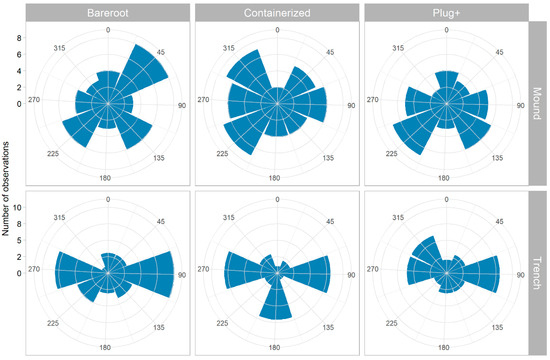
Figure 6.
Coarse root distribution of Norway spruce depending on soil preparation method and stock type (mounding pit or furrow are represented by 0 degrees, and berm is represented by 180 degrees).
Since there were no statistically significant differences between species (p = 0.54 in trenched sites and p = 0.39 in mounded sites) and the two forest types (p = 0.98 for birch, p = 0.91 for black alder, p = 0.67 for spruce and p = 0.84 for pine) nor stock type, they were further analyzed together. The only statistically significant (p < 0.001) difference was between soil preparation methods.
In trenches, 5% of trees developed only parallel roots, whereas 84% had parallel roots and at least one root growing in another direction (45° angle in any direction or perpendicularly), thus, likely ensuring better stability. None of the trees had main roots oriented only perpendicularly toward the furrow or berm, and 10% did not have roots running parallel to the trench. In trenches, 80% of trees had either three or four dominant roots, and 13% had five to six. In mounds, 73% had three or four dominant roots, and 27% had five to seven main roots. The coarse root count did not differ statistically, but overall, trees in mounds had a tendency to develop more roots. Birch and black alder, on average, developed slightly more coarse roots compared to other species (Figure 7).
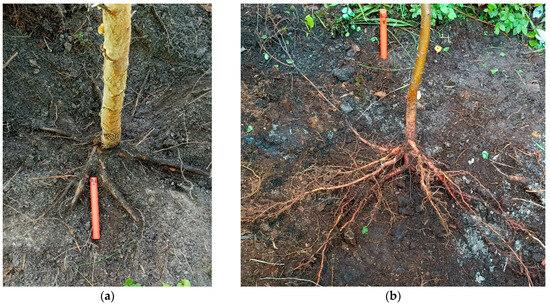
Figure 7.
Example of containerized silver birch uncovered roots in mounded site (a) and trenched site (b) in Myrtilloso–sphagnosa forest type.
3.2. Impact of Arginine Phosphate Fertilization on Root Development
In site B, there was no difference (p > 0.05) in the root development—length, depth (Figure 8), projected area, or weight—of control saplings and saplings with arGrowTM addition at the planting spot. Thus, at an early stage, addition of arGrowTM stimulant did not show any benefit in terms of root development.
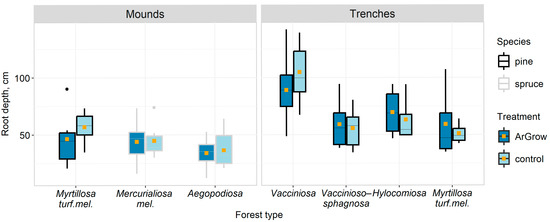
Figure 8.
Average maximum root depth of Scots pine and Norway spruce in 2022 in six forest types depending on soil preparation method and treatment (box represents interquartile range; median is shown as the center horizontal line in the box; whiskers show minimum and maximum observed values plus 1.5 × interquartile range or minus 1.5 × interquartile range, respectively; dots show outliers; mean root depth is represented by the orange squares).
A Generalized Linear Model (GLM) was conducted to examine the effect of the forest type, soil preparation method, and fertilization treatment on the root depth, root dry mass, and root projected area. There was no significant treatment and soil preparation method effect on any of the root parameters. Differences were best explained by forest type. Thus, models with only forest type as predictor had the lowest AIC values. The models included forest type as a categorical predictor with six levels: Hylocomiosa, Mercurialiosa mel., Myrtillosa turf.mel., Vacciniosa, Vaccinioso–sphagnosa, and Aegopodiosa (as reference type). All models were statistically significant (p < 0.01). Forest type explained approximately 62% of the variance in root depth (df = 120, F-statistic = 42.04), 47% of the variance in root dry mass (df = 119, F-statistic = 23.36), and 27% of the variance in root projected area (df = 131, F-statistic = 9.36).
The root projected area was assessed when trees were three (pine) to four (spruce) years old, and the root area was significantly larger in the Vacciniosa forest type compared to the Myrtillosa turf. mel. (p = 0.005) and Hylocomiosa (p < 0.001) forest types. In terms of the root dry mass, significant differences depending on forest type were seen in pine only when it was four years old (in 2022): dry roots were heavier in the Vacciniosa forest type compared to the Myrtillosa turf. mel. (p < 0.018) and Vaccinioso–sphagnosa (p < 0.018) forest types. The roots of four-year-old pine were significantly deeper in the Vacciniosa forest type compared to the Myrtillosa turf. mel. (p < 0.001), Vaccinioso–sphagnosa (p < 0.001), and Hylocomiosa (p = 0.021) forest types. The forest type did not significantly affect the development of spruce during the first years of growth.
Similarly to site A, in site B, there was also evidence of more radially symmetrical root distribution in mounds and a tendency toward two-sidedness in trenches (Figure 9 and Figure 10). However, statistical comparison cannot be clearly made because of the species differences (spruce was planted only in mounds) and planting under different forest type conditions.
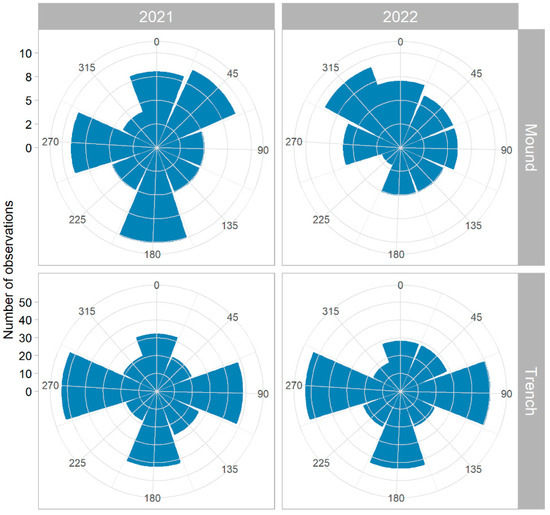
Figure 9.
Coarse root distribution of Scots pine depending on soil preparation method in 2021 and 2022 (mounding pit or furrow are represented by 0 degrees, and berm is represented by 180 degrees).
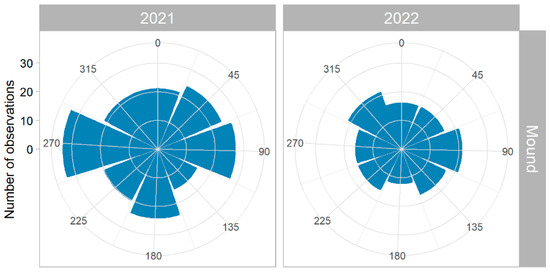
Figure 10.
Coarse root distribution of Norway spruce in mounds excavated in 2021 and 2022 (mounding pit or furrow are represented by 0 degrees, and berm is represented by 180 degrees).
4. Discussion
This study aimed to evaluate how soil preparation methods, stock type, forest type, and fertilization affect the early root spatial development of Scots pine, Norway spruce, silver birch, and black alder. Our hypotheses were that (1) early root pattern differences between forest types and species would be minimal; (2) the stock type would significantly influence the root spatial distribution due to planting process differences; and (3) mounds would promote radial root symmetry, while trenches would produce bidirectional root systems.
Contrary to our second hypothesis, the data showed that the stock type (containerized, bareroot, plug+) did not significantly affect early root spatial development. The results from study A serve as an interesting follow-up to our previous research and observations [14], where only containerized seedlings were assessed. In study A, bareroot and plug+ seedlings were also included. The root architecture development in bareroot saplings planted on mounded sites was expected to follow a similar pattern to those planted in trenched sites due to the typical planting method used for bareroot stock. This method generally involves creating a narrow slit in the soil with a spade, placing the roots into the slit, and then closing it, which could potentially flatten the root system. However, the data from this study did not support this expectation. Additionally, containerized saplings did not show a clear tendency to develop more radially distributed root systems in trenched sites. These observations suggest that the planting process itself, or the stock type, may not be the primary factors influencing early root architecture. Instead, it is consistent with our third hypothesis: the main difference was observed between soil preparation methods. This implies that soil structure may play a critical role in guiding root spatial development.
The soil preparation method seems to have had more of an effect on the root spatial distribution than the forest type, as there was no significant difference between the two forest types in study A. In study A, Myrtilloso–sphagnosa has sandy soil, and Myrtillosa turf. mel. is based on organic, drained peat soil.
In study B, there was no significant effect of the addition of arginine phosphate on root development in terms of the depth, length, weight, or projected root area. However, based on pine needle isotope data published by Bertins et al. [25], saplings did uptake the added fertilizer, but only in the Aegopodiosa and Myrtillosa turf. mel. type forests, where growing conditions are already generally richer compared to other forest types in this study. Yet the uptake did not lead to improved root growth in the early years. This aligns with other studies showing limited improvement in early development following fertilization with arginine phosphate [26,27,28,29,30,31]. Between the forest types, pine in the Vacciniosa forest type performed better compared to other forest types. While pine can tolerate a wide range of conditions, this is still surprising, as Vacciniosa is a forest type characterized by sandy soils and a thin organic matter layer, which is generally considered poor in terms of fertility and nutrients.
It is known that plants tend to produce long-running, pioneer roots that often grow into cavities, dents, or paths created by organic matter or macrofauna within the soil (e.g., cracks, holes, or channels) [32]. However, the density profile patterns of the soil were not assessed in this study, leaving this important variable unexamined. It is conceivable that the trenching process may have led to soil compression on the berm side, potentially affecting the root distribution by creating permeable pathways in some directions, while creating dense barriers in others. It can be speculated that roots followed the path of least resistance, which, in the case of trenched sites, would be parallel to the furrow, but in the case of mounds does not have a certain direction.
Other researchers have suggested that the nutrient and moisture distribution could influence root spatial development [33,34,35]. This does not contradict our findings, as the trenched microsites are likely to have a linear direction for the flow of nutrients and water; but this remains to be studied on a detailed scale. Interestingly, contrary to previous findings [14], there were more instances of roots developing toward the berm instead of the furrow. There can be multiple possible causes for this; the nutrient runoff into the furrow is not significant during early stages of regenerated forest, yet the berm holds the double layer of topsoil, which is typically richer in nutrients and organic matter. Root development toward the berm may also suggest compensatory anchoring, particularly, to counteract trunk leaning in the event of steep hinge formation [16]. Yet, it remains unlikely that the trench dimensions are the cause of the difference between the observations in this study and previous findings [14], since strict trench size guidelines are followed during disc trenching. This raises a question regarding the role of the furrow, hinge, and berm as planting spot locations. In the trenched sites of this study, trees were planted in hinges, as it is the standard practice and recognized as the best micro-location [36]. In theory, the top of the berm might seem like a planting spot similar to a mound, but their dimensions, soil structure, amount of air pockets, and other characteristics still differ [5]. The planting spot location effect on sapling growth parameters depends more on the quality of the spot rather than the location itself [37]; however, it remains unclear how planting on top of the berm or in the furrow itself influences root architecture.
Storms and unstable weather conditions are becoming increasingly more common and underscore the importance of stand resilience. Precautions need to be taken now to prevent possible damage in the future. Clearly identifying the factors affecting stand stability is crucial for future forest management. Research has shown that conifer species in hemiboreal forests are more prone to windthrow, whereas deciduous species exhibit a greater ability to withstand storms during the leafless periods. Additionally, certain species demonstrate enhanced resilience to waterlogging, further contributing to overall stand stability during extreme weather events [38]. Diseases, such as root rot in conifers [39] and ungulate-inflicted damage, can decrease trees’ mechanical stability [40,41]. Besides the differences between coniferous and deciduous trees, there are species-specific physiological differences, and they need to be considered in combination with the soil preparation method. For example, Norway spruce typically develops a shallow lateral root system coupled with an initially disturbance-sensitive taproot that can easily develop into a heartroot or sinker root system. This makes spruce especially susceptible to windfalls. However, the stability issues can be compensated for by the development of a wider root plate [21,32,42]. In contrast, pine trees develop a deeper root system and an anchoring taproot [32,42]. In terms of tree stability, the symmetry of the root plate is more important for species with a shallow root system [35]. As seen in this study, birch and black alder develop an extensive root system with more coarse roots that are more radially equally distributed compared to coniferous species. Moreover, black alder has a high potential to develop new adventitious roots from root primordia on its trunk. Hypothetically, these traits may offer deciduous species an advantage in terms of resilience during storms or heavy snowfall events [43], particularly when they occur during leafless periods in below-freezing temperatures [44].
During the early development, the main aim of soil preparation is to promote survival and development. In this aspect, both mounding and disc trenching increase survival and growth if compared to untreated soil [2,45,46,47,48]. It is important to evaluate if theoretical root development issues outweigh the benefits of each particular method (costs, expected growth rate, survival, drought and water resistance potential, etc.). Bidirectional root development along the furrow in trenched sites raises concerns only about long-term stand resilience and root anchoring strength. At this point, it remains unclear if early root architecture can promote or limit stand resilience. The results of this study suggest that black alder (followed by birch) has the best prospects for growing in trenched sites, whereas mounding would be better suited for pine and spruce in terms of root architecture development. Additionally, pine is more drought tolerant and benefits from the exposed mineral layer of mounds that prevents potential pine weevil (Hylobius abietis L.) damage [45,49]. While bidirectional root development along trenches raises concerns about long-term resilience, our data show that only 5% of trees planted in trenches developed strictly two-sided root systems, while 84% had parallel roots, plus at least one root at another angle, likely improving stability. In mounds, there were no cases of roots developing solely in a bidirectional root system.
We speculate that site scarification, such as inversion, screefing or scalping, and leaving without soil preparation, would lead to a similar root architecture to that observed in the mounded sites [50]. However, this falls beyond the scope of the present study, as these methods are not commonly practiced in Latvia since they are considered less suitable for the local climatic conditions, particularly as they do not facilitate runoff for excess water [46], which is often the main concern [5].
5. Conclusions
During the first five to six years of development, root architecture appears to be largely unaffected by the type of stock used, whether containerized, bareroot, or plug+, thus implying that initial root structure and the planting process itself have less of an effect on root spatial development after outplanting compared to the soil preparation method. In mounded sites, trees tend to develop a radially symmetrical root system, while in trenched sites, the root architecture is inclined to develop a bidirectional pattern aligned with the trench’s direction. This tendency is more distinct in all stock types of Scots pine and Norway spruce seedlings compared to black alder and silver birch, both of which developed more coarse roots overall and, thus, have a higher potential to develop a stronger root plate.
The addition of arGrow™ did not significantly influence the root architecture, depth, projected area, or dry weight for either Scots pine or Norway spruce during the first three years after outplanting. While the study did not assess the initial soil nutrient status, it still shows that under real-life field conditions in multiple forest types, the suggested fertilizer dosage does not provide a clear benefit to root development during early stages of development.
For forest managers, these findings emphasize the importance of matching soil preparation techniques to both species traits and site conditions to maximize long-term resilience and productivity. Future research should extend these insights through long-term monitoring, performing more in-depth assessment of microsites—addressing soil density, structure, moisture, and nutrient distribution patterns—and develop predictive models linking early root architecture to mature stand dynamics, particularly under disturbance pressures like storms or prolonged drought.
Author Contributions
Conceptualization, D.L.; methodology, D.L.; validation, S.Ž., K.D., and T.A.Š.; formal analysis, S.C.; investigation, K.D., T.A.Š., V.V., A.Z., and S.Ž.; resources, D.L.; data curation, S.Ž., K.D., and S.C.; writing—original draft preparation, S.C.; writing—review and editing, A.Z., and D.L.; visualization, S.C.; supervision, D.L. All authors have read and agreed to the published version of the manuscript.
Funding
This study was funded by the Latvia Council of Science national research program project “Forest4LV—Innovation in Forest Management and Value Chain for Latvia’s Growth: New Forest Services, Products and Technologies” (No.: VPP-ZM-VRIIILA-2024/2-0002).
Data Availability Statement
Dataset available on request from the corresponding authors.
Acknowledgments
The authors acknowledge and thank JSC “Latvia’s State Forests” for the possibility to establish study sites within the “Working methods and technologies for restoration, planting, care and protection of forest stands” program (agreement No. 5-5.9.1_007o_101_21_77) and LUA’s transition to the new doctoral funding model European Social Fund (ESF) (agreement No. 8.2.2.0/20/I/001) for funding data collection activities.
Conflicts of Interest
The authors declare no conflicts of interest.
References
- Löf, M.; Dey, D.C.; Navarro, R.M.; Jacobs, D.F. Mechanical Site Preparation for Forest Restoration. New For. 2012, 43, 825–848. [Google Scholar] [CrossRef]
- Heiskanen, J.; Saksa, T.; Luoranen, J. Soil Preparation Method Affects Outplanting success of Norway Spruce Container Seedlings on till Soils to Frost Heave. Silva Fenn. 2013, 47, 893. [Google Scholar] [CrossRef]
- Luoranen, J.; Laine, T.; Saksa, T. Field Performance of Sand-Coated (Conniflex®) Norway Spruce Seedlings Planted in Mounds Made by Continuously Advancing Mounder and in Undisturbed Soil. For. Ecol. Manag. 2022, 517, 120259. [Google Scholar] [CrossRef]
- Gemmel, P.; Nilsson, U.; Welander, T. Development of Oak and Beech Seedlings Planted under Varying Shelterwood Densities and with Different Site Preparation Methods in Southern Sweden. New For. 1996, 12, 141–161. [Google Scholar] [CrossRef]
- Sutton, R.F. Mounding Site Preparation: A Review of European and North American Experience. New For. 1993, 7, 151–192. [Google Scholar] [CrossRef]
- Uotila, K.; Rantala, J.; Saksa, T.; Uotila, P.H.; Rantala, K.; Saksa, J. Effect of Soil Preparation Method on Economic Result of Norway Spruce Regeneration Chain. Silva Fenn. 2010, 44, 511–524. [Google Scholar] [CrossRef]
- Zuševica, A.; Lazdiņa, D.; Štāls, T.A.; Dūmiņš, K. The Effect of Site Preparation on Vegetation Restoration in Young Hemiboreal Mixed Stands. Balt. For. 2023, 29, id705. [Google Scholar] [CrossRef]
- Latvijas Valsts Meži. Available online: https://www.lvm.lv/jaunumi (accessed on 6 May 2025).
- Kabala, C.; Bojko, O.; Medynska, A.; Szczepaniak, A. Spatial Variability and Temporal Changes in the Heavy Metal Content of Soils with a Deep Furrow-and-Ridge Microrelief Formed by an Afforestation Plowing. Environ. Monit. Assess. 2013, 185, 5141–5150. [Google Scholar] [CrossRef][Green Version]
- Dupuy, L.; Fourcaud, T.; Stokes, A. A Numerical Investigation into the Influence of Soil Type and Root Architecture on Tree Anchorage. Plant Soil 2005, 278, 119–134. [Google Scholar] [CrossRef]
- Gardiner, B. Wind Damage to Forests and Trees: A Review with an Emphasis on Planted and Managed Forests. J. For. Res. 2021, 26, 248–266. [Google Scholar] [CrossRef]
- Balisky, A.C.; Salonius, P.; Walli, C.; Brinkman, D. Seedling Roots and Forest Floor: Misplaced and Neglected Aspects of British Columbia’s Reforestation Effort? For. Chron. 1995, 71, 59–65. [Google Scholar] [CrossRef]
- Dumroese, R.K.; Owston, P.W. A User’s Guide to Nursery Stock Types. West. For. 2003, 48, 4–5. [Google Scholar]
- Celma, S.; Blate, K.; Lazdiņa, D.; Dūmiņš, K.; Neimane, S.; Štāls, T.A.; Štikāne, K. Effect of Soil Preparation Method on Root Development of P. Sylvestris and P. Abies Saplings in Commercial Forest Stands. New For. 2019, 50, 283–290. [Google Scholar] [CrossRef]
- Stamer, M.; Gurnell, A.M.; Bertoldi, W. Vertical root profiles of grey alder (Alnus incana) trees growing in highly disturbed river environments. River Res. Appl. 2024, 40, 1001–1011. [Google Scholar] [CrossRef]
- Wang, H.; Qin, J.; Hu, Y.; Guo, C. Asymmetric Growth of Belowground and Aboveground Tree Organs and Their Architectural Relationships: A Review. Can. J. For. Res. 2023, 53, 315–327. [Google Scholar] [CrossRef]
- Jansons, Ā.; Matisons, R.; Šēnhofa, S.; Katrevičs, J.; Jansons, J. High-Frequency Variation of Tree-Ring Width of Some Native and Alien Tree Species in Latvia during the Period 1965–2009. Dendrochronologia 2016, 40, 151–158. [Google Scholar] [CrossRef]
- Örlander, G. Effect of Planting and Scarification on the Water Relations in Planted Seedlings of Scots Pine; Swedish University of Agricultural Sciences, Faculty of Forestry: Uppsala, Sweden, 1986; ISBN 915762691X. [Google Scholar]
- Lazdiņš, A.; Petaja, G.; Bārdule, A.; Polmanis, K.; Kalēja, S.; Maliarenko, O.; Melnik, N. Fine Roots in Hemiboreal Forest Stands and Clearcut Areas with Nutrient-Rich Organic Soils in Latvia: Morphological Traits, Production and Carbon Input. Forests 2024, 15, 1500. [Google Scholar] [CrossRef]
- Dumroese, R.K.; Terzaghi, M.; Acevedo, M.; Lasserre, B.; Scippa, G.S.; Baggett, L.S.; Chiatante, D.; Montagnoli, A. Root System Architecture of Pinus ponderosa Three Decades after Copper Root Pruning in a Container Nursery. New For. 2022, 53, 983–1001. [Google Scholar] [CrossRef]
- Krišāns, O.; Samariks, V.; Donis, J.; Jansons, Ā. Structural Root-Plate Characteristics of Wind-Thrown Norway Spruce in Hemiboreal Forests of Latvia. Forests 2020, 11, 1143. [Google Scholar] [CrossRef]
- Liepa, I.; Miezīte, O.; Luguza, S.; Šulcs, V.; Straupe, I.; Indriksons, A.; Dreimanis, A.; Saveļjevs, A.; Drēska, A.; Sarmulis, Z.; et al. Latvijas Meža Tipoloģija; Latvijas Lauksaimniecības Universitāte Meža Fakultāte: Jelgava, Latvia, 2014; ISBN 9789984481647. [Google Scholar]
- Fantozzi, D.; Montagnoli, A.; Trupiano, D.; Di Martino, P.; Scippa, G.S.; Agosto, G.; Chiatante, D.; Sferra, G. A Systematic Review of Studies on Fine and Coarse Root Traits Measurement: Towards the Enhancement of Urban Forests Monitoring and Management. Front. For. Glob. Change 2024, 7, 1322087. [Google Scholar] [CrossRef]
- Core Team, R. R: A Language and Environment. R Foundation for Statistical Computing; Core Team, R: Vienna, Austria, 2024. [Google Scholar]
- Bertins, M.; Busa, L.; Lazdina, D.; Dumins, K.; Zake, S.; Klavins, M.; Viksna, A. Impact of Arginine Containing Fertilizer on Nitrogen Isotope Ratio and Elemental Content in Young Conifer Stands. Key Eng. Mater. 2022, 933, 185–192. [Google Scholar] [CrossRef]
- Schneider, A.N.; Castro, D.; Holmlund, M.; Näsholm, T.; Hurry, V.; Street, N.R. Effects of Small-Scale Outplanting Fertilization on Conifer Seedling Growth and Fungal Community Establishment. Trees For. People 2024, 16, 100568. [Google Scholar] [CrossRef]
- Castro, D.; Schneider, A.N.; Holmlund, M.; Näsholm, T.; Street, N.R.; Hurry, V. Effects of Early, Small-Scale Nitrogen Addition on Germination and Early Growth of Scots Pine (Pinus sylvestris) Seedlings and on the Recruitment of the Root-Associated Fungal Community. Forests 2021, 12, 1589. [Google Scholar] [CrossRef]
- Häggström, B.; Lutter, R.; Lundmark, T.; Sjödin, F.; Nordin, A. Effect of Arginine-Phosphate Addition on Early Survival and Growth of Scots Pine, Norway Spruce and Silver Birch. Silva Fenn. 2023, 57, 22013. [Google Scholar] [CrossRef]
- Häggström, B.; Domevscik, M.; Öhlund, J.; Nordin, A. Survival and Growth of Scots Pine (Pinus sylvestris) Seedlings in North Sweden: Effects of Planting Position and Arginine Phosphate Addition. Scand. J. For. Res. 2021, 36, 423–433. [Google Scholar] [CrossRef]
- Luoranen, J.; Salminen, T.; Gratz, R.; Saksa, T. Arginine Phosphate (ArGrow©) Treatment on Norway Spruce and Scots Pine Seedlings at Different Planting Times and under Varying Planting Site Conditions in Boreal Forests. For. Ecol. Manag. 2024, 563, 122012. [Google Scholar] [CrossRef]
- Luoranen, J.; Saksa, T. The Effects of Arginine Phosphate (ArGrow® Granulat) on Growth of Scots Pine and Norway Spruce Seedlings Planted in Varying Soil Layer Structures Simulating Site Preparation. For. Int. J. For. Res. 2023, 97, 580–589. [Google Scholar] [CrossRef]
- Puhe, J. Growth and Development of the Root System of Norway Spruce (Picea abies) in Forest Stands: A Review. For. Ecol. Manag. 2003, 175, 253–273. [Google Scholar] [CrossRef]
- Danjon, F.; Reubens, B. Assessing and Analyzing 3D Architecture of Woody Root Systems, a Review of Methods and Applications in Tree and Soil Stability, Resource Acquisition and Allocation. Plant Soil 2008, 303, 1–34. [Google Scholar] [CrossRef]
- Mou, P.; Mitchell, R.J.; Jones, R.H. Root Distribution of Two Tree Species Under a Heterogeneous Nutrient Environment. J. Appl. Ecol. 1997, 34, 645–656. [Google Scholar] [CrossRef]
- Coutts, M.P.; Nielsen, C.C.N.; Nicoll, B.C. The Development of Symmetry, Rigidity and Anchorage in the Structural Root System of Conifers. Plant Soil 1999, 217, 1–15. [Google Scholar] [CrossRef]
- Burton, P.; Bedford, L.; Goldstein, M.; Osberg, M. Effects of Disk Trench Orientation and Planting Spot Position on the Ten-Year Performance of Lodgepole Pine. New For. 2000, 20, 23–44. [Google Scholar] [CrossRef]
- Häggström, B.; Hajek, J.; Nordin, A.; Öhlund, J. Effects of Planting Position, Seedling Size, and Organic Nitrogen Fertilization on the Establishment of Scots Pine (Pinus sylvestris L.) and Norway Spruce (Picea abies (L.) Karst) Seedlings. Forests 2024, 15, 703. [Google Scholar] [CrossRef]
- Krišāns, O.; Matisons, R.; Kitenberga, M.; Donis, J.; Rust, S.; Elferts, D.; Jansons, Ā. Wind Resistance of Eastern Baltic Silver Birch (Betula pendula Roth.) Suggests Its Suitability for Periodically Waterlogged Sites. Forests 2021, 12, 21. [Google Scholar] [CrossRef]
- Krisans, O.; Matisons, R.; Rust, S.; Burnevica, N.; Bruna, L.; Elferts, D.; Kalvane, L.; Jansons, A. Presence of Root Rot Reduces Stability of Norway Spruce (Picea abies): Results of Static Pulling Tests in Latvia. Forests 2020, 11, 416. [Google Scholar] [CrossRef]
- Krisans, O.; Saleniece, R.; Rust, S.; Elferts, D.; Kapostins, R.; Jansons, A.; Matisons, R. Effect of Bark-Stripping on Mechanical Stability of Norway Spruce. Forests 2020, 11, 357. [Google Scholar] [CrossRef]
- Snepsts, G.; Kitenberga, M.; Elferts, D.; Donis, J.; Jansons, A. Stem Damage Modifies the Impact of Wind on Norway Spruces. Forests 2020, 11, 463. [Google Scholar] [CrossRef]
- Kalliokoski, T.; Nygren, P.; Sievänen, R. Coarse Root Architecture of Three Boreal Tree Species Growing in Mixed Stands. Silva Fenn. 2008, 42, 189–210. [Google Scholar] [CrossRef]
- Pellikka, P.K.E.; Järvenpää, E. Forest Stand Characteristics and Wind and Snow Induced Forest Damage in Boreal Forest. In Proceedings of the International Conference on Wind Effects on Trees, Karlsruhe, Germany, 16–18 September 2003; Ruck, B., Ed.; pp. 269–276. [Google Scholar]
- Peltola, H.; Kellomäki, S.; Hassinen, A.; Granander, M. Mechanical Stability of Scots Pine, Norway Spruce and Birch: An Analysis of Tree-Pulling Experiments in Finland. For. Ecol. Manag. 2000, 135, 143–153. [Google Scholar] [CrossRef]
- Nordin, P.; Olofsson, E.; Hjelm, K. Within-Site Adaptation: Growth and Mortality of Norway Spruce, Scots Pine and Silver Birch Seedlings in Different Planting Positions across a Soil Moisture Gradient. Silva Fenn. 2023, 57, 23004. [Google Scholar] [CrossRef]
- Pearson, M.; Saarinen, M.; Minkkinen, K.; Silvan, N.; Laine, J. Mounding and Scalping Prior to Reforestation of Hydrologically Sensitive Deep-Peated Sites: Factors behind Scots Pine Regeneration Success. Silva Fenn. 2011, 45, 647–667. [Google Scholar] [CrossRef][Green Version]
- Lazdiņa, D. Gala Ziņojums. Par Pētījuma 2016—2020. Gada Galvenajiem Rezultātiem: Meža Atjaunošanas, Ieaudzēšanas Un Kopšanas Programma; Silava: Salaspils, Latvia, 2020. [Google Scholar]
- Lazdiņa, D. Pārskats Par Pētījuma 2023. Gada Rezultātiem: Darba Metodes Un Tehnoloģijas Mežaudžu, Ieaudzēšanai, Kopšanai Un Aizsardzībai; Silava: Salaspils, Latvia, 2023. [Google Scholar]
- Luoranen, J.; Viiri, H. Soil Preparation Reduces Pine Weevil (Hylobius abietis (L.)) Damage on Both Peatland and Mineral Soil Sites One Year after Planting. Silva Fenn. 2012, 46, 151–161. [Google Scholar] [CrossRef]
- Heineman, J.L.; Bedford, L.; Sword, D. Root System Development of 12-Year-Old White Spruce (Picea glauca (Moench) Voss) on a Mounded Subhygric-Mesic Site in Northern Interior British Columbia. For. Ecol. Manag. 1999, 123, 167–177. [Google Scholar] [CrossRef]
Disclaimer/Publisher’s Note: The statements, opinions and data contained in all publications are solely those of the individual author(s) and contributor(s) and not of MDPI and/or the editor(s). MDPI and/or the editor(s) disclaim responsibility for any injury to people or property resulting from any ideas, methods, instructions or products referred to in the content. |
© 2025 by the authors. Licensee MDPI, Basel, Switzerland. This article is an open access article distributed under the terms and conditions of the Creative Commons Attribution (CC BY) license (https://creativecommons.org/licenses/by/4.0/).